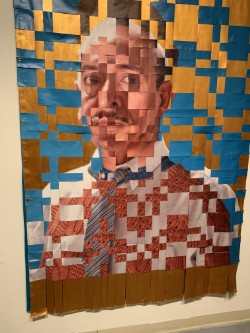Curatorial Activism is defined as a way for art curators to collect and exhibit art that does not fit the status quo. It focuses more on justice and righteousness of defying the government's and society's corrupt power and influence, demonstrating freedom through the form of activist art. It has always been a curators job to introduce new audiences to the meaning behind each art piece that brings out the problematic injustice the artists have to endure in society and the discrimination they face. Feeding the audience every important info that has led to the art being made and eventually being put into a popular museum. In the book, “This is what I know about Art” by Kimberly Drew, she states that “On Social media, I aimed to connect the burgeoning #BlackTwitter community to Black Art. My primary strategy was to use it to entice Black audiences to come to the museum.” This was one of the ways that Kimberly had to captivate the audience through her tumblr, Instagram or any other social media platform to have more visitors come to the museum. It just proves that true dedicated Activism curators like Kimberly Drew would go out of their way to present people the history and meanings of the galleries and why it’s worth paying a visit. For example, one of the Kimberly posted a call for art support of Black Lives matter on her Black contemporary Art on her tumblr after the incident of Michael Brown’s death, it was considered a healing and mourning space for anyone who wanted to experience art that has tried to offer sense in an ear-piercing time and it’s something an audience whether online or in person can quite relate to and share their opinions and as well as connecting with one another. Kimberly also states in the book that” For three years, with the power of social media, I tried to show as many people how many doors there could be to the institution.” Letting people in to show off the incredible work of activism artists who are women, Black, or any other ethnicity than just being another typical White male.
Gabriel Garcia Roman was one of the two artists in the Latin Lens event whose work I liked and appreciated. His art was a collage of fragments of both his father and himself that were placed together while they were in the same place. His story of how he began painting portraits was a very personal one. "As a child and even as an adult, I never really had a great relationship with my father," Gabriel said. On the day of the photography session, his father passed away, and he was completely emotionless when he learned of it. Gabriel made an effort to go through all of his father's photos after his death in an attempt to find whatever feelings he might have. He eventually discovered a picture of himself striking the same position as his father. Then, with the goal to create a united image, by printing out the photos in larger sizes and then cutting out portions of the photos of both himself and his father. Gabriel claims that his father is the reason he is who he is. He was also able to communicate his pain and stress over his father through this image, turning it into something beautiful and, in a sense, paying tribute to him.
I also developed respect and affection for portrait photographer Josefina Fernandez Moran. Originally from Argentina, she eventually relocated to the United States to pursue a degree in photography. Additionally, Josefina and her mother did not get along and always had a tense relationship. Then, she would take a photo of her mother and realize that there was more to her mother than she had previously imagined, and she decided to examine her more closely in order to gain a deeper understanding of her and decided to talk to her. According to Josefina, she and her mother are now on better terms and are making an effort to understand one another. She also said that sometimes time passes too quickly for two people who obviously want to improve their relationship before it's too late to ever get back those times.


No comments:
Post a Comment